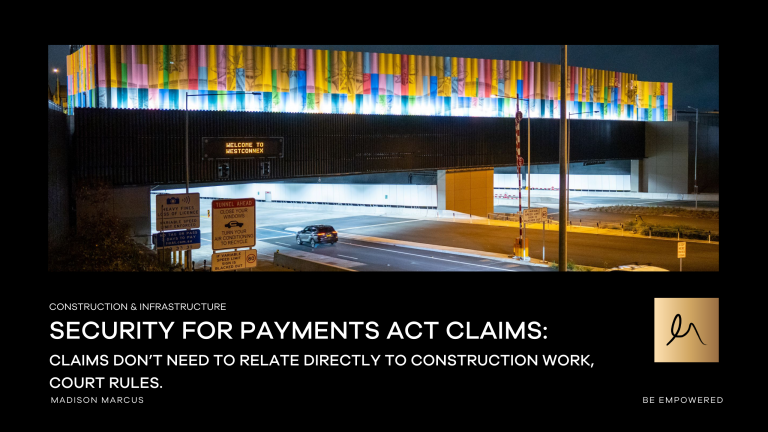A creditor’s statutory demand is a formal written request requiring a company to pay a debt within 21 days from service of the demand.
A failure to respond to a statutory demand has serious consequences and should not be ignored. It can lead to a presumption if insolvency and consequentially lead to the company being placed into liquidation.
You only have 21 days to take action with respect to a statutory demand, so it is important that you act swiftly and seek appropriate legal advice.
What is a creditor’s statutory demand?
A statutory demand is made under section 459E of the Corporations Act 2001 (Cth) (Act), which provides that the demand must:
- relate to a debt or debts that are at least $2,000;
- adequately specify the debt and its amount;
- be in writing, and in the prescribed form (form 509H);
- require compliance (i.e., payment) within 21 days after it is served on the company;
- be signed by or on behalf of the creditor; and
- be accompanied by an affidavit (which cannot predate the statutory demand) that verifies that the debt is due and payable and complies with the rules if the debt is not a judgment debt.
What are my options after receiving a statutory demand?
Generally, a company will have three (3) options available after receipt of a creditor’s statutory demand. These options, which must be undertaken within 21 days from the date you are served, include:
- Pay the debt – if you do not dispute that the debt is due and accept the amount, you should pay the debt before the 21 days has lapsed.
- Try and settle with the creditor – if you cannot pay the debt in full, dispute part of the debt, or want to negotiate alternative payment terms which would extend past the 21-day period, you should contact and negotiate with the creditor for alternative payment arrangements. This may include providing security for the debt (such as a charge over your land and/or personal property), to the satisfaction of the creditor. If such arrangements are agreed to, you will need to ensure that the statutory demand is withdrawn, as it cannot be extended (unless it is done through Court).
- Apply to the Supreme Court to set aside the statutory demand – There are 4 grounds under which you can set aside the demand (which are outlined below). However, the most common ground is if you genuinely dispute the existence or the amount of the debt.
Failure to take action within the strict 21-day deadline will lead to a presumption of insolvency. A company is insolvent when it is unable to pay its debts as and when they fall due, which will give the creditor grounds to make an application to wind up your company and to appoint a liquidator over the company.
How do I set aside a statutory demand?
A statutory demand is set aside by making an application to the Supreme Court under section 459G of the Act for an order setting aside the demand.
You have a strict 21 days to make the application. This includes not just filing the application in Court but also serving the application on the creditor who issued the statutory demand. Problems often arise when a company files the demand but finds itself unable to serve it on time, which is fatal to the application.
Section 109X of the Act provides that a company may be served by, amongst other things, leaving it at, or posting it to, the company’s registered office or delivering the document to a director of the company who resides in Australia.
The application to set aside the demand will need to be supported by an affidavit setting out the grounds under which you are applying to set aside the demand.
Grounds to set aside a creditor’s statutory demand
A statutory demand can be set aside by the Supreme Court if it is satisfied that:
- There is a genuine dispute about the existence or amount of the debt to which the statutory demand relates. This requires that:
- The dispute be bona fide and truly exist in fact; and
- The grounds for alleging the existence of the dispute are real, not spurious, hypothetical, illusory or misconceived.
- The company has an offsetting claim against the creditor. In order to offset the claim, it must be genuine and must be a counter-claim, cross-demand or a set-off. Any cross-demand does not need to arise out of the same transaction as the statutory demand.
However, this only assists to offset the debt in the demand by your offsetting claim. The Court can vary the demand and reduce it by the amount of your offsetting claim, so if it is above the statutory minimum, you will still be required to pay it or risk the presumption of insolvency. - Because of a defect in the demand, substantial injustice will be caused unless it is set aside. Defects in a demand are defined as:
- an irregularity;
- a misstatement of an amount or total;
- a misdescription of a debt or other matter; and
- a misdescription of a person or entity.
The defects must cause ‘substantial injustice’ to the debtor.
Examples of substantial injustice as a result of a defect include gross overstatement of the amount owed; failure to set out the basis in which the amount is owed; failure to provide sufficient information to ascertain what the debt relates to; and including a debt that is not yet due for payment.
- There is some other reason the demand should be set aside. This normally includes some unconscionability or abuse of process on the part of the creditor. Some examples of ‘some other reason’ include:
- serving a demand that includes amounts that the issuer knows are disputed;
- the supporting affidavit being sworn prior to the date of the demand;
- where the judgment debt supporting the demand has been set aside;
- failing to include an affidavit verifying the debt (for debts which are not judgment debts); and
- failing to verify that the debt is due and payable or the absence of a genuine dispute of the debt.
What happens if the demand is set aside?
If a statutory demand is set aside, then pursuant to section 459K the statutory demand has no effect. Additionally, under section 459N if the Court has set aside a statutory demand the Court may order that the creditor pays for the company’s costs in relation to the application.
Still need help?
If you have been served a statutory demand and need help understanding your options and navigating the process, or want to issue a statutory demand against a company that owes you money, do not hesitate to contact the experienced lawyers at Madison Marcus to see how we can help you.







